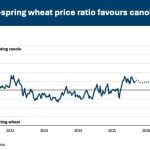The winter that will likely go down in the record books as one of the warmest will also go down as the year that made livestock producers smile.
Dave Guichon, with grain brokerage Ag Value Group, believes above normal temperatures have allowed feedlots to finish cattle 10 percent earlier and with 10 percent less feed.
“It’s a fairly significant amount,” said Guichon.
Stephen Pain, a senior trader with Western Feedlots, said the warm weather has generated huge savings for the operation’s three southern Alberta feedlots.
Read Also

Farmers urged to be grain-safe this fall
Working around grain bins comes with risk, from farmers falling to drowning in grain: Experts have five tips to help avoid grain-related accidents this harvest.
“It’s been dramatic,” said Pain, who thinks calves that went on feed in the fall will be finished at least a month earlier than normal. “We’re seeing some excellent conversions and some phenomenal daily gains.”
He estimated the company is using 2,000 to 3,000 fewer bushels of grain a day because of the warm weather.
“It’s been a feeder’s dream.”
It is also saving money on bedding. The company has already hauled the manure out of the pens, a job that is usually not done until the spring.
“It’s just been a gift, an all out gift,” said Pain.
Brad Welter, cattle manager for Poundmaker Ag Ventures in Lanigan, Sask., said it too has saved on feed costs because of the mild winter.
One of the biggest bonuses has been for the staff who work with the stock.
“The people that have to work outside in it appreciate it,” said Welter.
While they haven’t done a detailed analysis, Welter believes Poundmaker has saved money by using less electricity to keep water bowls free of ice and has had fewer machinery repairs.
Mark Silzer, a bison producer from Humboldt, Sask., said he hasn’t seen huge feed savings, because the bisons’ good winter coat helps insulate them from the cold.
“Certainly there are some reductions, but not as much as you would see in a herd of cattle.”
This year, Silzer said the biggest saving is the reduction in feed prices from previous years.
“That’s been greater than any weather-related benefits.”
Grant Hirsche, a purebred Hereford and Angus producer from High River, Alta., said he’s almost finished calving his first group of cows and there isn’t a frozen ear among the calves.
“Its been unbelievable weather,” said Hirsche, who brings the cows into a large calving barn to calve and dry off before going back outside.
The warm weather has increased the incidence of scours and the dusty pens have brought on some pneumonia in the calves.
“It’s still very positive and a lot easier,” said Hirsche, who estimates he’s saving hundreds of dollars in reduced fuel bills to heat the calving barn.
In British Columbia, Brenda Wilson of Little Fort said they are also enjoying the mild winter. It’s cold enough there to keep the brown ground from getting muddy.
“The weather has been great,” said Wilson.
Harry Brooks, crop specialist with Alberta Agriculture at the Alberta Ag Info Centre in Stettler, Alta., said most producers enjoy not having to push through fields of snow to get at feed.
“At this time, there is no indication we’re going to have a drought. Even if we didn’t get much snow, it mostly affects run off and most of the dugouts are filled from last year’s good moisture.”














